Content marketing is all about creating valuable, engaging content that connects with your audience. Here are 15 standout content marketing examples that showcase different approaches, from blogs and videos to social media campaigns. These examples highlight how brands use content to inform, entertain, and drive results.
- HubSpot Blog: Educational posts that generate 3,000 leads monthly by solving real problems.
- Canva Blog: One of our favorite content marketing examples features design tips paired with templates, empowering users to create instantly.
- Notion Blog: Productivity advice tailored to individual needs, with practical tools.
- Glossier Blog: Relatable beauty stories that build community and trust.
- Duolingo TikTok: Viral, humorous content featuring their quirky mascot.
- Morning Brew Instagram: Business news made fun with memes and humor.
- Ryanair TikTok: Self-deprecating humor that turns complaints into viral moments.
- Goop Instagram: Wellness content mixing sleek visuals with playful charm.
- Slack Instagram: Workplace humor that connects with professionals.
- Ahrefs Blog: Data-driven SEO insights that establish authority.
- Spotify Wrapped: Personalized music stats that users love to share.
- LinkedIn B2B Institute: Research infographics that simplify complex data.
- BuzzFeed Quizzes: Interactive, shareable content with high engagement.
- Loom Video Library: Personal product demos that build trust.
- Zendesk Customer Stories: Short case studies showing measurable results.
Quick Comparison
| Example | Content Type | Key Strategy | Impact |
|---|---|---|---|
| HubSpot Blog | Blog | Educational how-to guides | 3,000 leads/month |
| Canva Blog | Blog | Actionable design tips + templates | 125M monthly users |
| Notion Blog | Blog | Personal productivity tips | 147M website visits |
| Glossier Blog | Blog | Relatable beauty stories | 70% sales from referrals |
| Duolingo TikTok | Social Media | Humor-driven, trend-focused content | 16.8M TikTok followers |
| Morning Brew Instagram | Social Media | Memes + business insights | 52% follower growth |
| Ryanair TikTok | Social Media | Self-aware humor | 2.2M TikTok followers |
| Goop Instagram | Social Media | Lifestyle content with humor | 1.5M Instagram followers |
| Slack Instagram | Social Media | Workplace humor | 87K Instagram followers |
| Ahrefs Blog | Blog | SEO data studies | 400K organic visits/month |
| Spotify Wrapped | Interactive Campaign | Personalized user data | 156M users engaged |
| LinkedIn B2B Institute | Infographics | Simplified research insights | 80% of B2B leads from LinkedIn |
| BuzzFeed Quizzes | Interactive Content | Fun, shareable quizzes | 96% completion rate |
| Loom Video Library | Video | Personal product demos | 37% better conversions |
| Zendesk Stories | Case Studies | Problem-solution narratives | 369% ROI for clients |
These content marketing examples show how different content formats can drive engagement, build trust, and achieve measurable success. Whether it’s blogs, videos, or social media, the key is to focus on your audience’s needs and create content that’s both useful and engaging.
10 MOST CREATIVE Content Marketing Examples
1. HubSpot Blog – Showcases How-To Guides as Content Marketing Examples
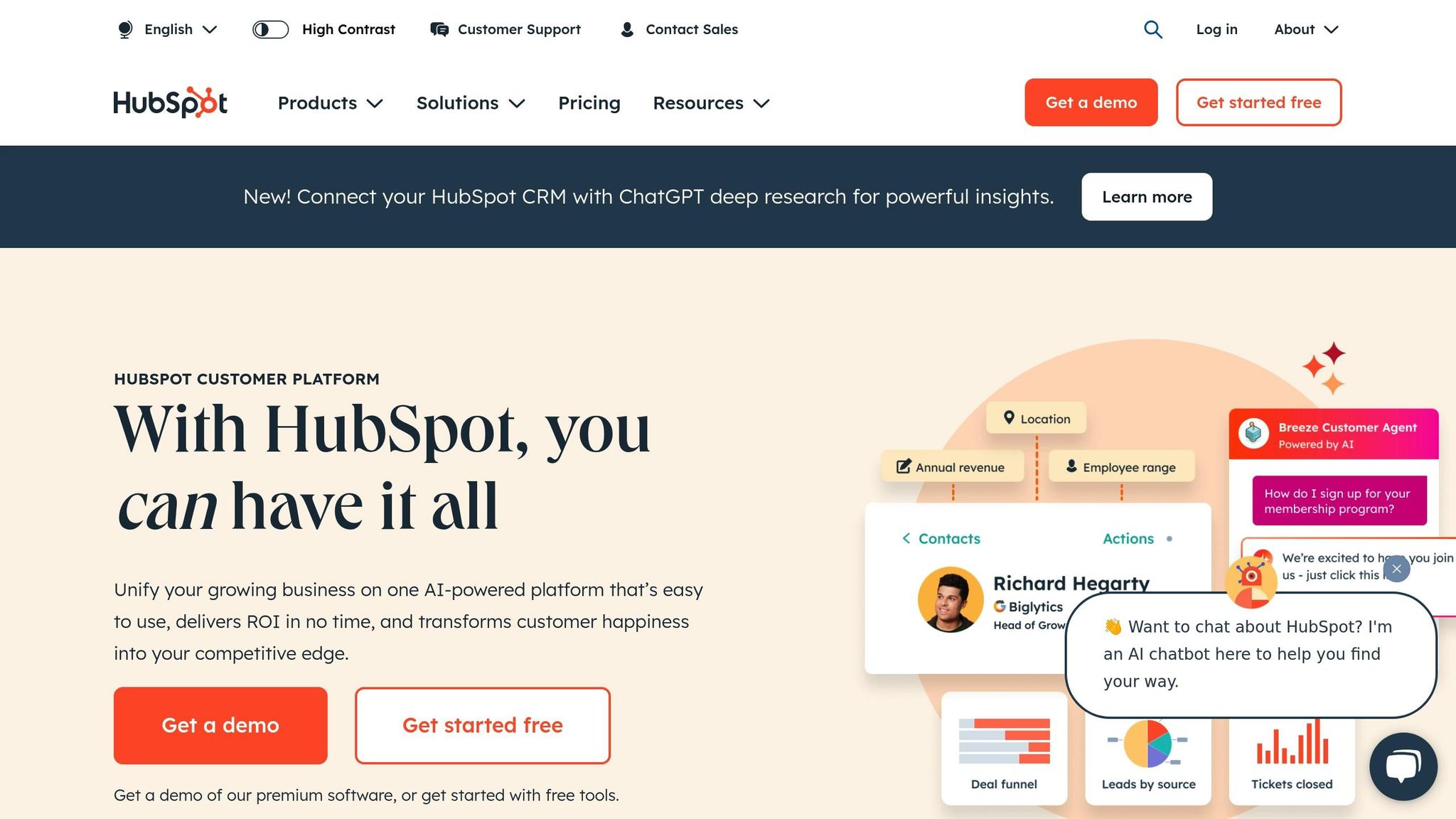
HubSpot has mastered the art of creating educational content that doesn’t just inform – it converts. Their blog brings in an impressive 3,000 leads every month by addressing real-world challenges rather than simply promoting their products [4]. When they do mention their tools, it’s only when those tools genuinely solve the issue being discussed, helping customers work smarter and more effectively [3]. This is one of the best content marketing examples for AI search.
“Your product may be a solution, but if you’re not explicitly writing a product page, you should only incorporate product mentions if they make sense.” [3]
This thoughtful approach is evident in their email marketing guide. The guide covers everything from strategy to design principles and best practices, offering readers actionable advice. HubSpot’s email tool is presented as just one of several solutions, making it feel like a helpful resource rather than a sales pitch. This builds trust and positions the tool as a practical option – without pressuring the reader.
HubSpot’s content strategy is also tailored to match different stages of the buyer’s journey. Their content for the awareness stage educates readers, the consideration stage compares options, and the decision stage showcases practical applications. This layered approach reinforces their reputation as a reliable source of guidance [3].
Another standout aspect of their strategy is involving employees from various departments in content creation. This ensures a variety of perspectives and areas of expertise are represented, enriching the content’s value [4]. This is especially important given that 44% of buyers engage with three to five pieces of content before reaching out to a vendor [3]. By offering multiple touchpoints, HubSpot positions itself as a trusted partner rather than just another company trying to sell something.
What lands HubSpot’s blog on our list of top content marketing examples is its focus on delivering useful, educational content instead of promotional material. Whether a reader becomes a customer or not, they walk away with actionable knowledge – and that’s what keeps them coming back.
2. Canva Blog – Design Ideas With Built-In Templates (One of our Favorite Content Marketing Examples)
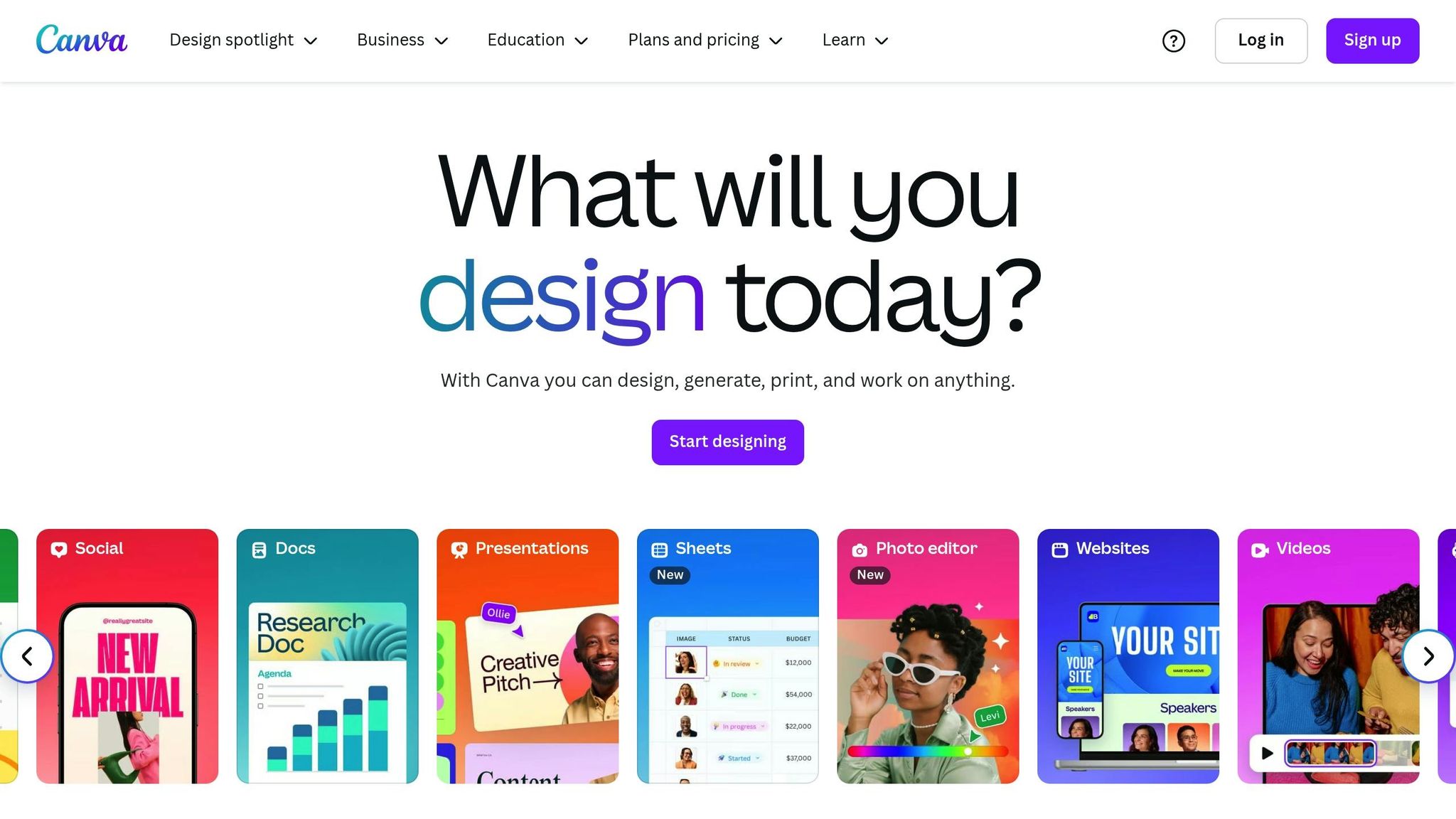
Canva has nailed the art of content marketing by combining design inspiration with instant usability. Their “Learn” blog doesn’t just showcase what great design looks like – it hands you the tools to create it yourself, right then and there.
With more than 125 million monthly active users across 190 countries [9], Canva’s “Learn” blog covers everything from design and marketing to branding, business strategies, nonprofit projects, and education [5]. Every article is crafted to be immediately actionable, which is why it’s among our top content marketing examples.
Take their post on call-to-action button design as an example. Instead of merely discussing color theory or contrast, Canva provides real-world examples and practical tips on button size, color, and contrast [6]. Readers don’t just learn what works – they understand why it works and can dive straight into creating their own buttons using Canva’s ready-made templates.
This seamless transition from inspiration to execution is Canva’s secret sauce. By offering a comprehensive suite of templates, design elements, free photos, and fonts, Canva empowers anyone – even those with zero graphic design experience – to produce professional-quality visuals and graphics [9].
Their content strategy revolves around long-form educational posts, inspirational articles, design-focused newsletters, and a treasure trove of free resources [9]. Whether it’s quiz templates, e-book layouts, infographics, or presentation designs, Canva provides thousands of content marketing examples to kickstart your projects [8]. Like HubSpot’s user-first approach, Canva bridges the gap between learning and doing, laying a strong foundation for innovative social media strategies discussed later.
This approach benefits both beginners and seasoned creators. A small business owner experimenting with social media design can instantly test ideas using Canva’s Instagram templates. Meanwhile, a nonprofit exploring infographics can start building data visualizations within minutes. By reducing barriers for new users and streamlining workflows for pros, Canva ensures everyone can create with confidence [9].
This combination of education and execution has played a key role in Canva’s $39 billion valuation [9]. By removing the friction between learning and doing, Canva transforms readers into active users, highlighting that great content marketing examples don’t just inform – they drive action.
One standout feature is the ability to embed Canva designs on websites with automatic updates whenever changes are made [7]. This ensures that users can refine and iterate on their work without starting over, adding long-term value to their creations. Canva’s blend of teaching and doing sets the stage for more creative and effective social content strategies.
3. Notion Blog – Personal Productivity Content
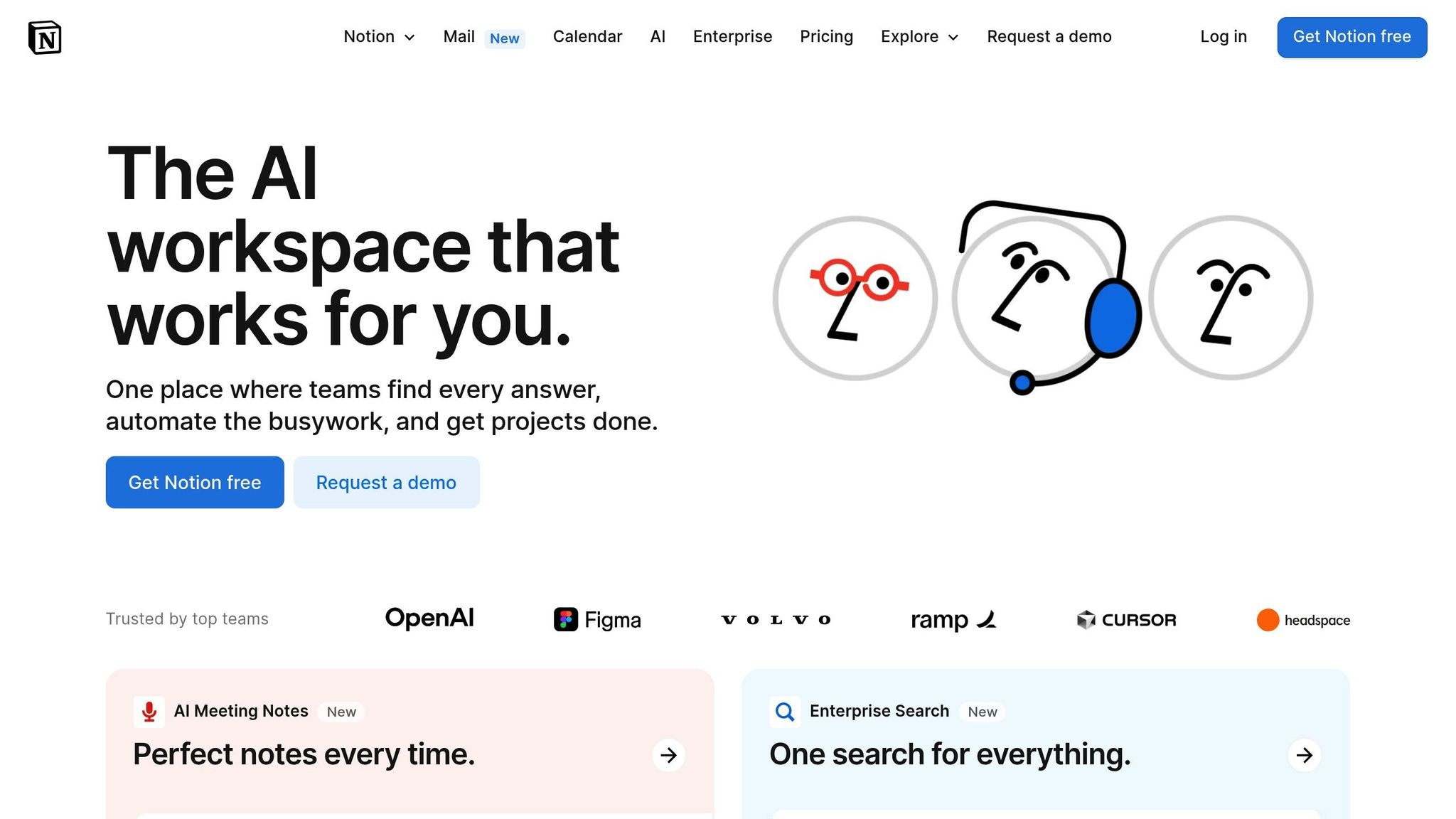
Notion takes productivity advice and transforms it into personal, actionable guidance. Unlike platforms that push rigid systems, Notion’s blog recognizes that productivity isn’t one-size-fits-all. Instead, they offer flexible solutions designed to fit individual work styles.
What lands Notion on our Best Content Marketing Examples list is how it tackles common frustrations – digital clutter, scattered information, and disorganized workflows – through relatable storytelling and practical advice. They manage to address these pain points without coming across as preachy or overly idealistic.
Philippe Larroque, Product Manager & Product Marketer at Notion, sums up their philosophy well:
“Notion adapts to your habits, it helps you to personalize your definition of clarity.” [10]
This focus on the user is central to their content strategy. Instead of promoting a one-size-fits-all system, Notion’s blog explores varied approaches to organization, goal-setting, and task management. They acknowledge that a freelance designer’s needs are vastly different from those of a corporate team lead.
The Personal Touch That Converts
Notion’s blog often starts with scenarios that professionals can relate to: an overwhelming Monday inbox, project files scattered across platforms, or to-do lists that never seem to work. These familiar situations immediately connect with the reader.
When addressing challenges like procrastination or goal-setting, Notion avoids generic advice. Instead, they offer specific strategies, such as breaking objectives into smaller, manageable tasks. Larroque explains this approach:
“Notion isn’t a magic wand that instantly transforms your habits into productivity. It gives you the means to define your objectives, track them and break them into little pieces of work.” [10]
This realistic tone resonates with readers who are tired of overpromises and quick fixes, ranking high among content marketing examples that are honest and practical to build trust and credibility.
Beyond insights, Notion’s blog delivers actionable advice. Where many productivity blogs rely on abstract theories, Notion provides detailed setups and workflows. Their content includes template recommendations, step-by-step guides, and specific instructions that readers can implement right away.
For professionals struggling with consistency, their blog offers practical tools like minimalist dashboards, time-blocking techniques, habit trackers, and calendar integrations. These aren’t just ideas – they’re tested solutions designed to solve real problems.
Community-Driven Content Strategy
With a global user base exceeding 100 million, and 80% of those users located outside the U.S. [11], Notion taps into its diverse community to create content that resonates across industries and cultures. Their blog features real user stories, shared templates, and community-generated solutions, adding authenticity to their content. User stories is content marketing examples
Notion’s engagement metrics speak volumes. The platform’s website, Notion.so, attracts approximately 147.4 million visits, with users spending an average of over nine minutes per visit [11]. This shows how their personal, practical approach keeps readers coming back for more.
Larroque’s final words encapsulate Notion’s content philosophy:
“If Notion isn’t the magic stick, see it more as a flashlight that can guide you through the darkness of the modern world based on constant notification and attention-seeking.” [10]
This metaphor perfectly captures why Notion’s content works so well. They position themselves as a helpful guide, not a miracle cure, and this honesty fosters genuine connections with readers. By offering relatable, user-focused content, Notion proves that practical advice and storytelling can drive engagement. Their approach mirrors the storytelling mastery seen in brands like Glossier, further cementing their place as a standout example of content marketing done right.
4. Glossier Blog (‘Into the Gloss’) – Stories With Tutorials
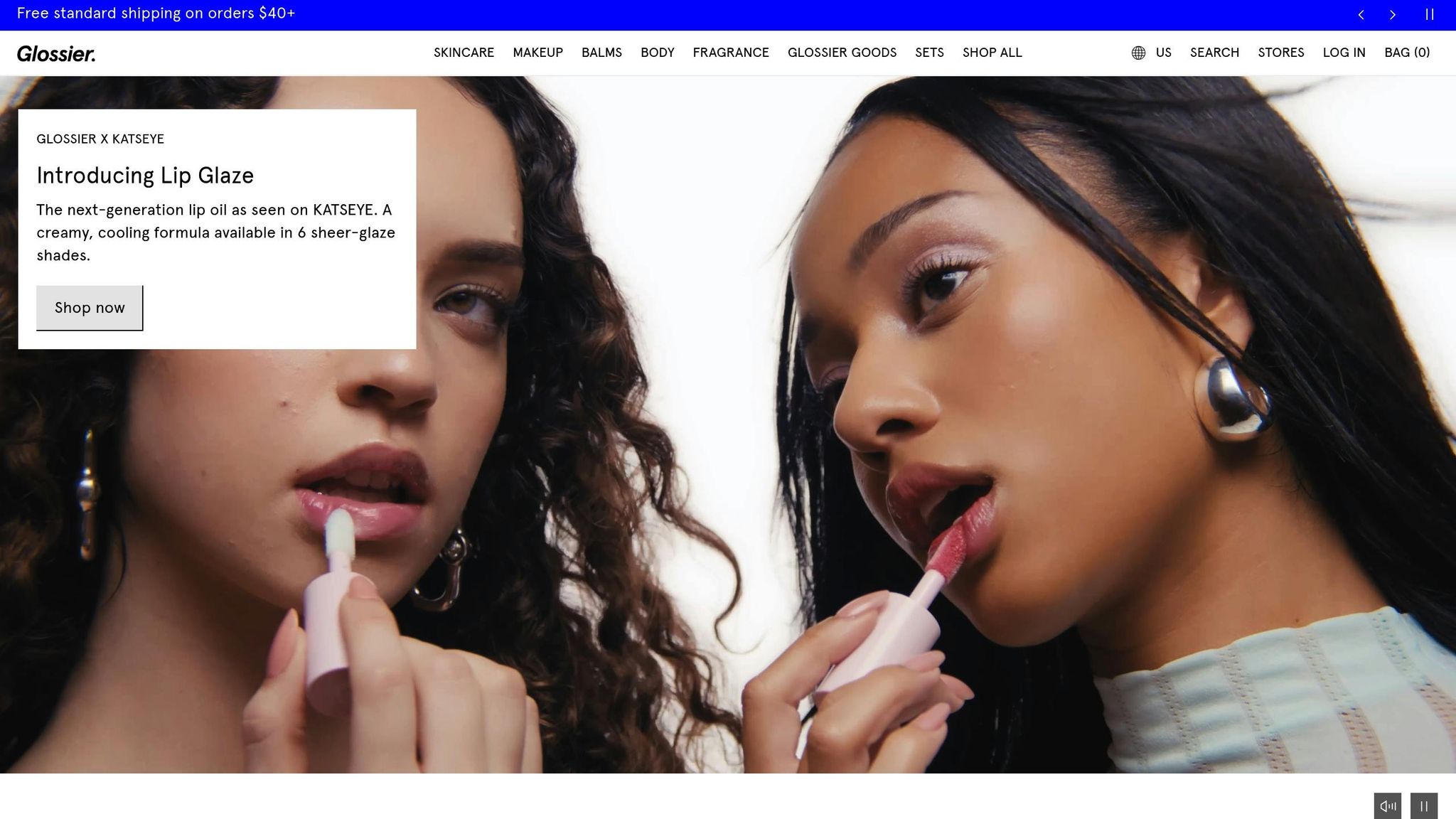
Glossier’s “Into the Gloss” blog reshaped beauty content by focusing on the real experiences of women. Founder Emily Weiss built a platform where people could connect through honest conversations about beauty, rather than being bombarded with sales pitches. This approach fostered a sense of community and authenticity that stood out in the beauty industry.
One of the blog’s standout features is “The Top Shelf,” where women from diverse backgrounds share their beauty routines and favorite products [12]. This shift – from glossy, unattainable marketing to relatable, real-life stories – was a game-changer.
As Emily Weiss explained:
“I wanted to start this new conversation around product that was more through the lens of personal style, rather than beauty be coming from a product- or launch-driven perspective.” [17]
This vision struck a chord. By 2012, less than two years after its launch, “Into the Gloss” was pulling in 200,000 unique visitors and 4.5 million page views monthly [17]. By the following year, traffic surged to 2 million unique visitors per month, with over 120,000 social media followers [17].
Community-Driven Product Development
Glossier took their content strategy a step further by involving their audience in product creation. A great example of this is the development of their Milky Jelly Cleanser. In January 2015, they asked readers to share ideas for a “dream face wash”, and the response was huge – 380 comments full of suggestions [13]. These insights directly shaped the product, which went on to become one of Glossier’s bestsellers.
Ali Weiss, Glossier’s Director of Marketing, highlighted the importance of this collaborative process:
“Development started on Into The Gloss. Comments on the open thread helped decide what the product would be, and we were able to bring the customers on the journey with us.” [17]
This approach not only led to a successful product but also deepened the connection between the brand and its community. Readers weren’t just learning from tutorials – they were actively shaping the brand’s future.
Authentic Storytelling That Builds Trust
Glossier’s success also lies in its ability to tell genuine stories that resonate with its audience. By leaning into user-generated content, the brand built trust and loyalty. Instead of relying on traditional beauty campaigns, Glossier showcased everyday women using their products in their daily lives. This strategy stood in stark contrast to the typical approach of speaking at customers, as Emily Weiss observed:
“I realised that there was a real disconnect between the beauty brands and the customer. They weren’t communicating with her – they were talking down to her, or speaking at her, rather than having a conversation, which was leaving a lot of women at arm’s length.” [18]
Glossier’s mantra, “Beauty in real life,” highlights their commitment to authenticity [14]. By featuring smaller creators and everyday individuals instead of just celebrities or professional models, the brand embraced natural beauty and made their audience feel seen.
The results speak for themselves. 70% of Glossier’s online sales and traffic come from peer-to-peer referrals, and 8% are driven by Instagram brand ambassadors [15]. Their Instagram page quickly grew to over 2.5 million followers, demonstrating the power of their community-driven approach [16].
The Power of Individual Influence
A cornerstone of Glossier’s strategy is the belief that every customer is an influencer. Emily Weiss put it simply:
“At Glossier, something we’ve always stayed very true to, since pre-launch, day one, is that every single person is an influencer.” [15]
This philosophy drives their content creation. Rather than relying on traditional advertising, Glossier empowers customers to share their personal stories and experiences. As Weiss explained:
“The best thing we can do is give people content. That is our main driver of growth.” [15]
5. Duolingo TikTok – Mascot-Led Social Content
Duolingo has turned its language-learning app into a TikTok sensation, thanks to its mischievous mascot, Duo the owl. What started as harmless app reminders has evolved into a stream of wildly entertaining content that prioritizes humor and spontaneity over dry grammar lessons.
Over the last four years, Duolingo’s TikTok following skyrocketed from 50,000 to a staggering 16.8 million. Meanwhile, monthly active users jumped from 40.5 million in 2021 to 116.7 million, and quarterly billings reached $192.6 million – up 40% year over year [21][22]. These numbers show how leaning into bold creativity can fuel both engagement and revenue growth.
The Chaos-Driven Marketing Playbook
Duolingo’s secret sauce? It’s all about embracing the chaos. Their social media team operates with a level of freedom that’s rare in corporate marketing. Zaria Parvez, Duolingo’s Global Senior Social Media Manager, calls it “unhinged marketing” and explains:
“Our social content mirrors community desires, reacting promptly to trends. It’s a priority.” [22]
This quick, trend-driven approach has paid off. Take, for example, a Valentine’s Day TikTok where Duo posted a cheeky “thirst trap” in response to a user comment. The video raked in 1.27 million engagements and achieved a 19.9% engagement rate – nearly five times the average for brands [19]. Even the comment section becomes a source of inspiration for their team:
“The comment section is our social brief.” [21]
Turning Trends Into Moments
Duolingo doesn’t just jump on trends – they take them over. In 2024, they sent employees dressed as Duo to Charli XCX’s BRAT tour, creating viral moments as concertgoers shared their surprise encounters online [20]. Then in February 2025, they staged a dramatic stunt where Duo was “killed” in faux news updates and a mock investigation. By the time the owl made its comeback, the campaign had generated millions of interactions and trended globally [20].
One standout TikTok featuring a Finn Wolfhard meme amassed 8.5 million views and 1.54 million engagements – nearly four times the average engagement for their videos [19]. Another video of Duo attending an Enhypen concert saw engagement rates that outperformed competitors by a wide margin [19].
From Meme to Marketing Genius
What makes this strategy so effective is how it ties back to the product. Chief Marketing Officer Manu Orssaud explains:
“When you see an owl twerking on TikTok, the first thing that comes to mind is, ‘Oh, I haven’t done my Duolingo today.'” [21]
These viral moments double as reminders to use the app. Parvez adds:
“We really have it down pat internally on our social team [in terms] of who Duo is, what Duo believes, his likes, his dislikes, the way he presents himself.” [25]
Imperfect, Yet Impactful
Duolingo’s willingness to experiment and embrace imperfection sets it apart from traditional corporate social media. As Parvez puts it:
“You can’t plan virality. But you can plan mentality. Our openness to being scrappy and experimenting [is] what has set us apart.” [23]
This raw, unpolished approach resonates with audiences. Parvez elaborates:
“Humans don’t like advertising… A normal consumer, quite frankly, doesn’t really care about your brand. They’re just looking for emotions to feel whenever they see content – and that can be funny, it can be disturbing, it can be informative.” [25]
The results speak volumes. At VidCon 2022, Duo was featured as a creator rather than a brand, drawing longer lines than influencers like Anna Sitar [23]. Today, Duolingo has more TikTok followers than global giants like Nike, McDonald’s, and Disney [24].
Duolingo’s TikTok success proves that great content marketing doesn’t have to follow the rulebook. By giving Duo a personality and trusting their team’s creativity, they’ve built a fanbase that eagerly anticipates whatever chaos comes next.
6. Morning Brew Instagram – Data Plus Humor
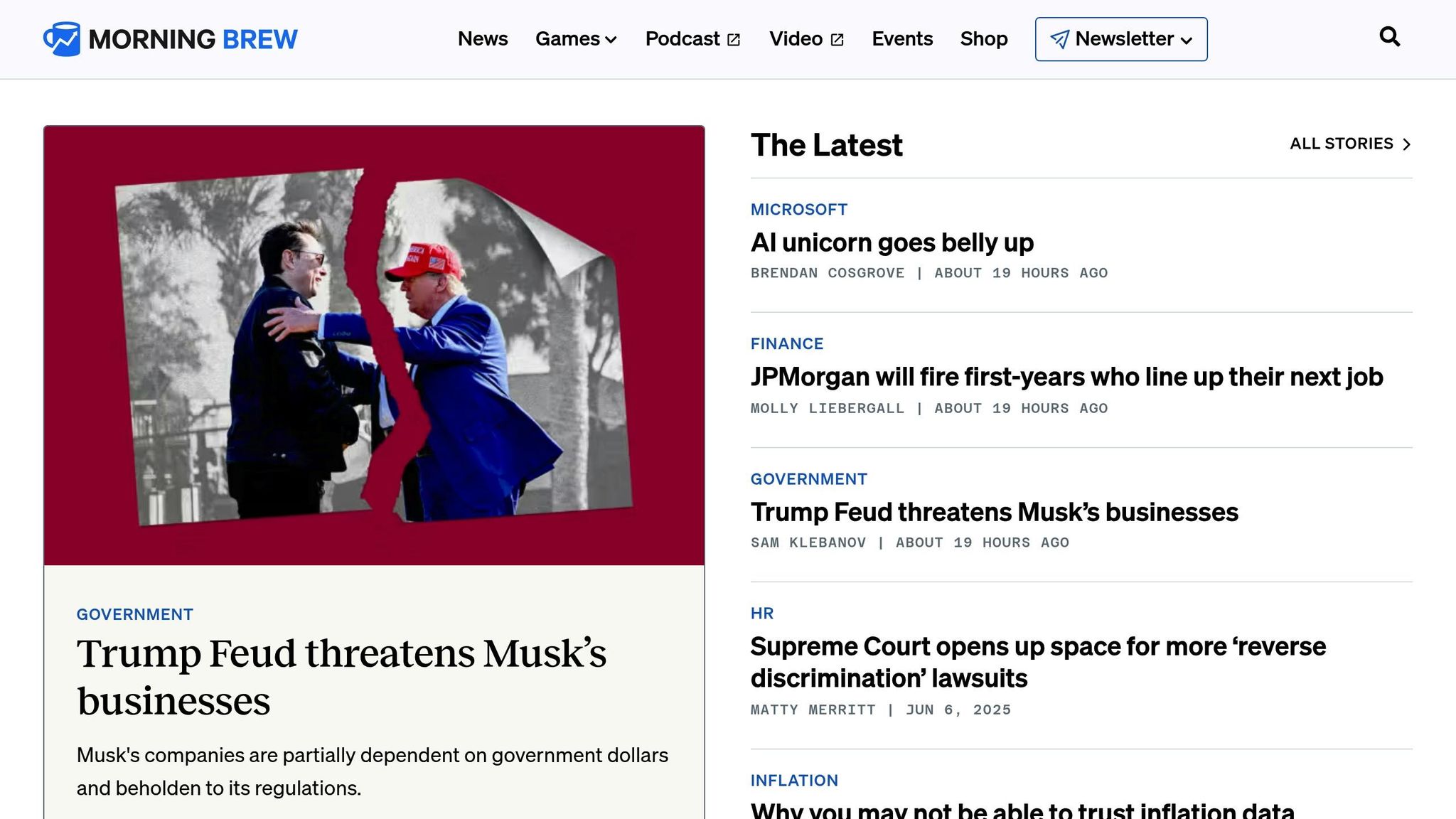
Morning Brew has figured out how to make business news anything but boring. Unlike the typical financial outlets that rely on dull charts and complex jargon, Morning Brew takes market data and turns it into content that’s fun, engaging, and shareable.
Their Instagram strategy boils down to one core idea: make business news feel like a chat with your smartest, wittiest friend. It’s clearly working – over the past year, their follower count jumped 52%, reaching 4.5 million followers across platforms [27].
The Winning Mix: Data and Humor
The secret sauce? Morning Brew knows how to turn trends and data into memes and relatable posts. Instead of traditional infographics, they create content that feels right at home on Instagram while still delivering valuable business insights.
In 2024 alone, their non-video content brought in 768 million impressions (a 134% increase from the previous year), while their short-form videos racked up 760 million views (up 89% year-over-year) [27]. These numbers highlight how well their unique approach resonates with audiences.
Rachel Karten, author of Link in Bio, sums it up perfectly:
“Morning Brew breaks down hard-to-understand finance reporting into clear, entertaining threads and videos [that] should be studied by all media.” [27]
Consistency Across Platforms Builds Trust
Morning Brew’s success isn’t just about clever Instagram posts – it’s about a unified content strategy. They seamlessly connect their Instagram presence to their broader ecosystem by cross-publishing and referencing other content assets. Their tagline, used across both Twitter and Instagram, says it all: “…from Wall Street to Silicon Valley, daily” [26].
This consistency extends to their conversational tone. Co-founder Alex Lieberman explains their approach:
“Morning Brew’s goal at the highest level is to empower the modern business leader with engaging and accessible content.” [29]
Their results back this up. Their daily email boasts a 45% open rate [28], while their overall email open rate hovers around 42% [26] – figures that most brands can only dream of.
Simplifying the Complex
Morning Brew excels at breaking down financial topics in a way that’s easy to digest and fun to read. This approach resonates especially well with millennials and Gen Z professionals who crave clear, entertaining insights [27].
Co-founder Austin Rief highlights why this strategy works:
“We realized early on that word-of-mouth and referrals were going to be key to our success. We focused on creating content that people would want to share.” [29]
And share they do. Humor consistently drives the best engagement on social media [31], and Morning Brew taps into this by turning even the driest business topics into content people enjoy and share.
Funny Means Business
Morning Brew’s humor-driven content isn’t just about likes and shares – it’s about building a thriving business. In 2019, they pulled in $13 million in ad revenue [30], proving that entertaining content can have serious financial rewards.
7. Ryanair TikTok – Self-Aware Trend Content
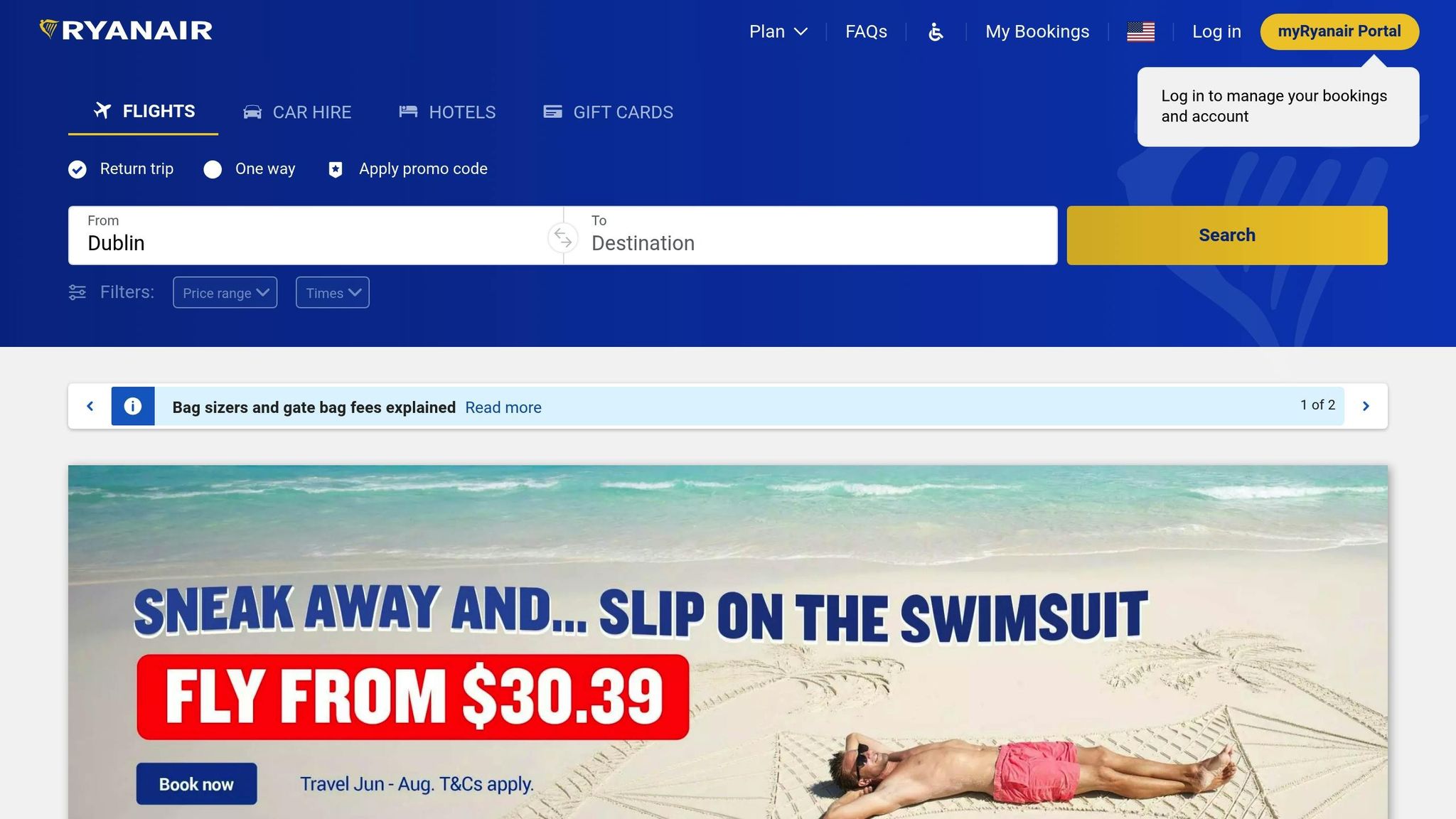
While most airlines work hard to present a polished image, Ryanair takes a completely different route – they lean into their budget airline reputation with humor that resonates. Their TikTok strategy shows that sometimes the best way to handle criticism is to laugh along with it. And judging by their 2.2 million followers and over 36 million likes on TikTok [38], it’s a strategy that works.
Turning Complaints Into Shareable Moments
Ryanair has a knack for flipping customer complaints into viral content. Rather than issuing bland apologies, they turn grievances into punchlines. For example, when passengers complained about the windowless seat 11A, Ryanair didn’t shy away. Instead, they created the #11AClub, turning it into a quirky inside joke [38]. And when asked about USB charging outlets, their cheeky response – “yeah, they’re just under the seat massage function” – was a hit [35]. Even criticism about their window seats led to a sarcastic quip about raising fares [35].
This approach works because it feels real. As Alex Doan from Nextiva put it:
“Ryanair has turned its no-frills reputation into social media gold by fully embracing self-deprecating humor.” [36]
Riding TikTok Trends With Style
Ryanair doesn’t just post content – they dive headfirst into TikTok culture. Their team uses trending Gen Z slang in captions [37] and jumps on viral formats with impressive speed. For instance, they created a “Ryanair Wrapped” video, inspired by Spotify’s popular year-end trend [32], seamlessly blending current trends with their brand.
The numbers back up their strategy. Ryanair averages 1 million views per TikTok post, with some videos reaching a staggering 15 million views [37]. Their engagement rate by views sits at 9.6%, far above TikTok’s average [33]. Much of their success comes from their simple yet effective formula: short, funny videos under ten seconds [33], featuring trending sounds and their signature plane face filter. This approach not only entertains but also drives measurable business results.
How Humor Boosts Business
Ryanair’s bold content strategy isn’t just for laughs – it delivers real results. Their social media engagement leads to 22% more direct bookings, and their cost per acquisition is 60% lower than the industry average [39].
CEO Michael O’Leary credits their success to a hands-off approach:
“We hired a group of kids under the age of 25 and sent them forth and said ‘Look, write whatever you want on Twitter, Facebook, Instagram, TikTok.'” [38]
This freedom allows their team to turn criticism into viral moments without getting bogged down by corporate red tape.
Why Self-Deprecation Wins
Ryanair’s approach works because it’s transparent and relatable. As Chatdesk explains:
“Ryanair shows self-awareness by getting in on the joke. Ryanair also builds trust by showing their customers that the airline actively listens to them.” [34]
When someone mocked their social media team as “20-something woke imbeciles”, Ryanair’s response – “admins new bio” – was another example of their quick wit [35]. By owning the criticism, they made it part of their brand identity.
This strategy has helped them dominate TikTok compared to competitors like easyJet (262,000 followers) and Wizz Air (61,000 followers). Ryanair’s 2.2 million followers give them a massive edge [38].
The takeaway for other brands? Authenticity trumps perfection. As marketing expert Ilan Nass puts it:
“Authenticity > Production Value. Your audience would rather see the real, messy, honest version of your brand than another overly polished corporate façade.” [39]
Ryanair proves that embracing your flaws and turning them into part of your story can transform weaknesses into strengths. Their self-deprecating humor is a masterclass in how being real and relatable can create content that not only entertains but also drives results. This approach sets an example for other brands looking to connect with audiences in a meaningful way.
8. Goop Instagram – Lifestyle Brand Content
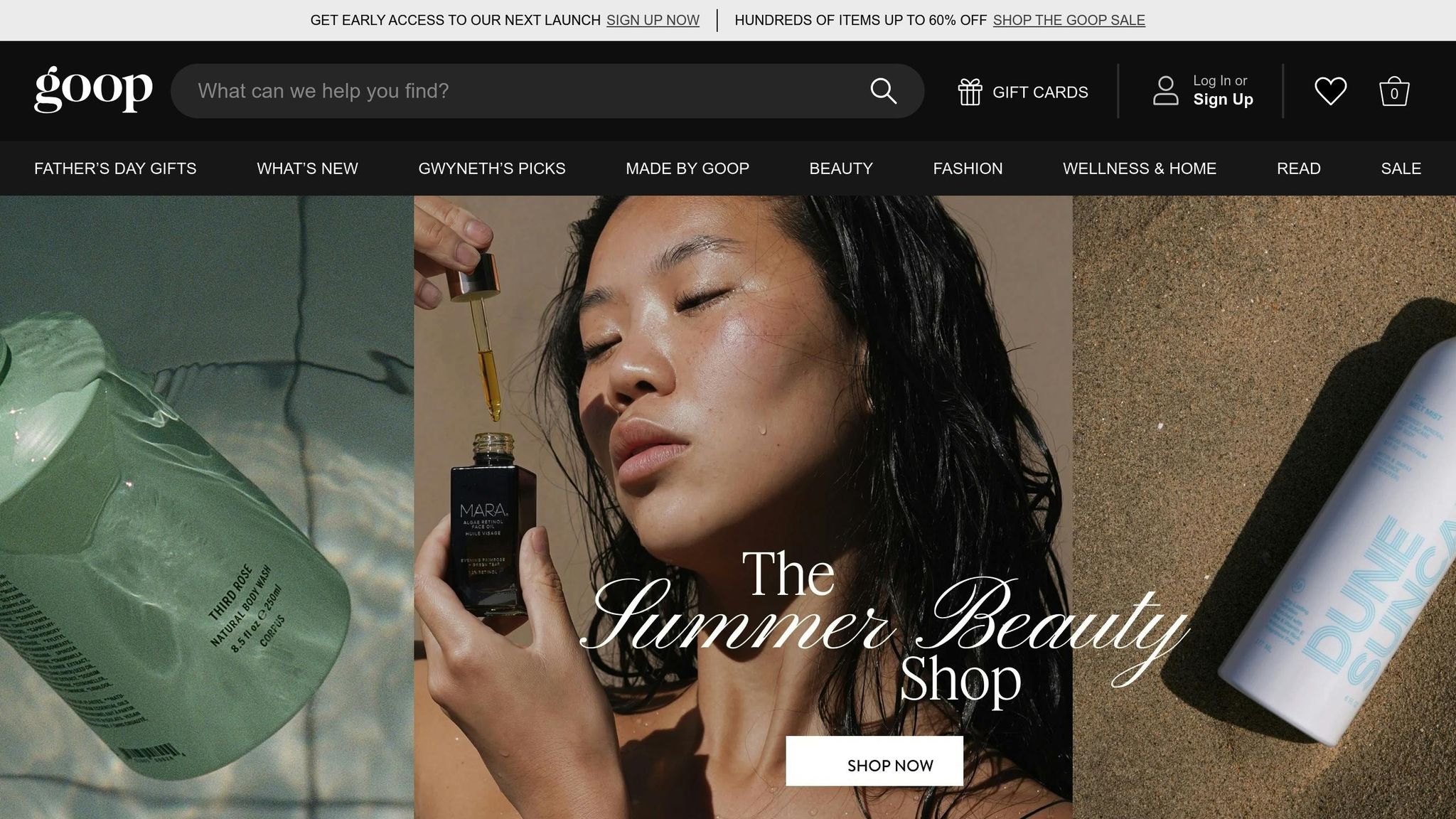
Gwyneth Paltrow’s wellness empire, Goop, strikes a balance between aspirational visuals and a touch of self-aware humor. With over 1.5 million followers [47] and a 1.9% engagement rate [40], Goop showcases how direct-to-consumer (D2C) brands can excel at storytelling.
The Perfect Blend of Polished and Playful
Goop’s Instagram approach revolves around sleek visuals paired with wellness-focused content [40]. What sets them apart is their ability to mix high-end wellness with a dose of humor. For example, the brand has embraced the term “Goopy” and isn’t afraid to laugh along with jokes about its unconventional wellness advice [41]. This self-awareness not only makes the brand memorable but also reinforces a consistent and approachable identity. Their messaging remains “relentlessly positive” [45], creating a unique mix of sophistication and relatability that resonates with followers.
Content That Feels Personal
One of Goop’s standout strategies is making its Instagram feel like a reflection of Gwyneth Paltrow’s own life and beliefs [44]. The posts mirror her lifestyle, making the content feel genuine and relatable. Whether it’s skincare tips or wellness advice, the brand seamlessly integrates its story into its product offerings [44]. It feels less like a sales pitch and more like a trusted friend sharing firsthand recommendations.
As Goop puts it:
“We take a curious, unbiased, open-minded and service-centric approach to the work we do. We test the waters so that you don’t have to” [41].
Building a Strong Community
Goop takes engagement seriously. They don’t just post and vanish – they actively interact with their followers [47]. The brand also keeps its content dynamic by collaborating with influencers and hosting staff-led takeovers. These takeovers often feature team members or influencers sharing skincare routines and wellness tips through posts and Stories [46]. A great example of their collaborative power was in 2015 when Gwyneth Paltrow’s appearance on The Ellen DeGeneres Show sparked 1.4 million Instagram interactions [42]. It’s a testament to how strategic partnerships can amplify reach and engagement.
Reaching Beyond Instagram
While Instagram remains Goop’s main stage, the brand has ventured onto TikTok to connect with a younger audience. Their TikTok content includes behind-the-scenes glimpses and quick beauty tips, helping them grow to over 186,000 followers [40]. This expansion highlights their ability to adapt and maintain relevance across platforms.
Goop’s success lies in its ability to combine luxury wellness with a lighthearted, quirky charm. By staying aspirational yet approachable, the brand has mastered the art of D2C storytelling, building both engagement and loyalty [43].
sbb-itb-16c0a3c
9. Slack Instagram – Workplace Humor Content
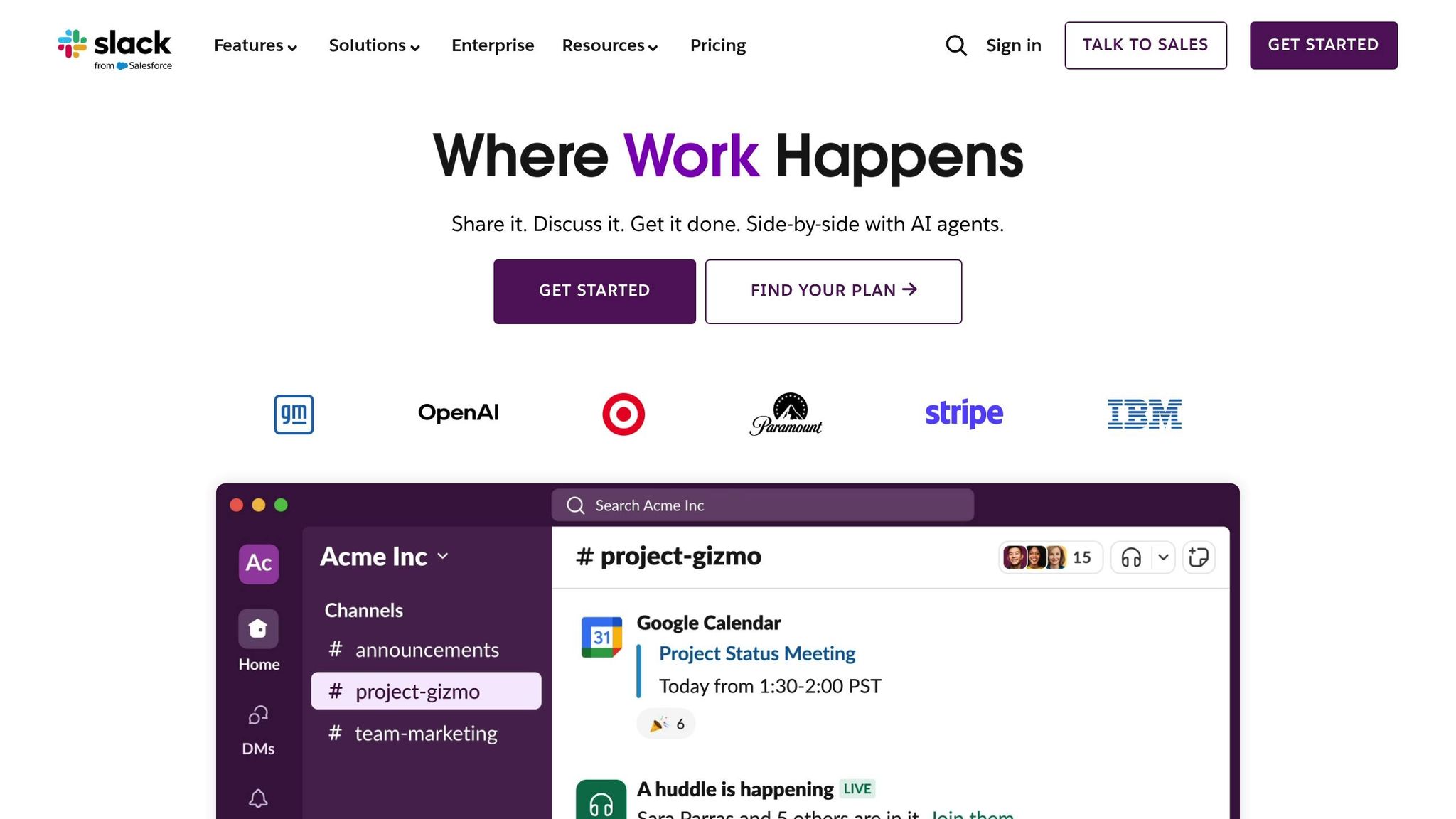
Slack has figured out how to make B2B content marketing not just informative but also genuinely entertaining. With an Instagram following of over 87,000 people [48], the workplace communication platform connects with professionals by leaning into humor that mirrors everyday office life. It’s a great example of how even technical brands can strike a chord with their audience through wit and relatability.
Turning Corporate Jargon into Comedy Gold
Slack’s Instagram strategy shines because it doesn’t shy away from the quirks of workplace culture. Instead of avoiding corporate buzzwords, they embrace them, turning “collaboration clichés” into laugh-out-loud moments [50]. For instance, in 2024, Slack ran a poll asking followers to vote for their most hated workplace jargon [50]. This not only tapped into shared frustrations but also positioned Slack as a brand that understands its audience on a personal level.
Variety That Keeps Followers Engaged
What sets Slack apart is the diversity of its Instagram content. Their feed is a lively mix of funny skits, customer success stories, product updates, and educational posts [48]. By mixing it up, they avoid the monotony often associated with B2B content. Plus, their posts have a consistent visual style, making them instantly recognizable [49]. Whether it’s a quick Reel showcasing new features or a Story spotlighting customer testimonials, every piece of content feels like it’s part of a cohesive, engaging brand narrative.
Humor That Drives Real Results
Injecting humor into B2B marketing isn’t just about laughs – it delivers measurable results. Studies reveal that 72% of people prefer brands that make them laugh over their competitors, and brands using humor see an 80% boost in customer loyalty [51]. Slack nailed this balance in 2024 with a video for World Dyslexia Awareness Day. The post highlighted their new dyslexia-friendly font feature while using their trademark humor [48]. It was a perfect mix of social impact and lightheartedness, showing that humor can also carry a meaningful message.
The Thought Process Behind the Fun
Slack’s approach to interactive marketing content is rooted in a clear philosophy. As the company explains:
“Our culture, when it is inwardly focused, develops our product; when it is outwardly focused, it creates our brand. Our company’s identity and the things we stand for in the workplace are reflected in our brand” [49].
This mindset is why their humor feels natural – it’s a reflection of their users’ real-world experiences.
Why This Approach Works for B2B
Slack proves that B2B content doesn’t have to be dull. In fact, 48% of buyers say they’re tired of the same old B2B marketing and crave more creativity and humor from brands [94, 95]. By offering moments of levity and relatability, Slack creates genuine connections with its audience [51]. They use Instagram Reels to share updates, tap into trending hashtags and audio, and strike a balance between educating and entertaining [49]. Slack shows that even the most technical brands can come to life when they focus on being human.
Slack’s success on Instagram is a reminder that humor, when done right, can make even the most technical brands feel approachable and relatable.
10. Ahrefs Blog – SEO Data Studies
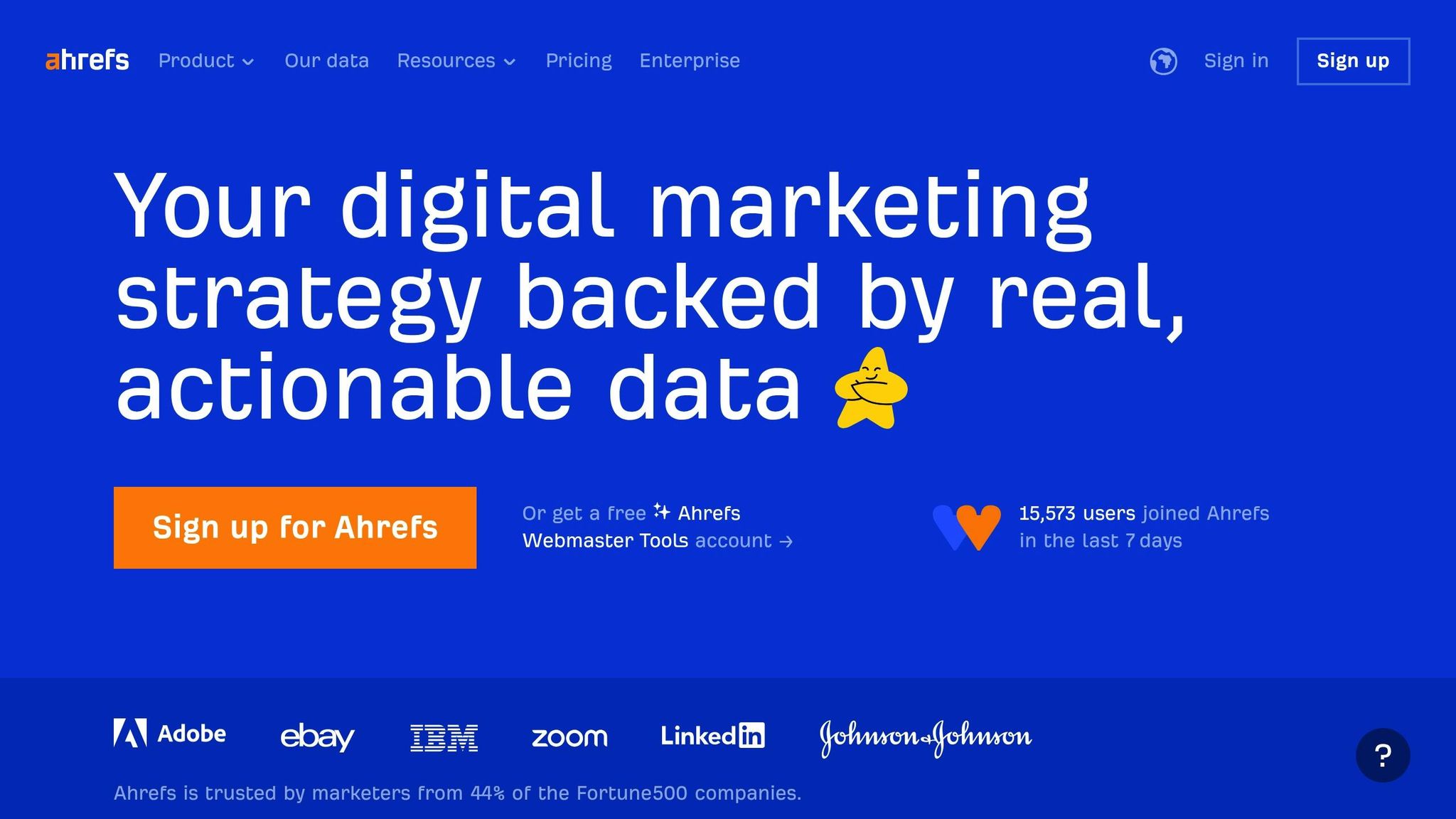
Ahrefs has mastered the art of turning complex SEO data into content marketing examples that inform, engage, and build trust. With a staggering 400,000+ organic visits per month, their blog showcases how data-driven content marketing can establish credibility and authority in the SEO industry [55]. By transforming raw data into practical insights, Ahrefs makes technical SEO concepts accessible and actionable for marketers.
Original Research That Builds Credibility
Ahrefs taps into its own massive SEO platform, which crawls over 6 billion web pages daily and manages a keyword database with more than 10 billion entries across 171 countries. This unique access allows them to produce studies that are unmatched in the industry [54]. Their approach focuses on turning raw data into insights that marketers can immediately put to use.
One standout example is their “SEO Statistics” post. This single article has earned over 1,777 referring domains and ranks for the term “SEO statistics”, attracting 1,100 visitors every month [53]. This demonstrates how original research can achieve two goals at once: providing valuable information to readers while also earning high-quality backlinks that enhance search rankings.
Making Complex Data Digestible
Ahrefs excels at breaking down dense SEO concepts into manageable, easy-to-understand pieces. Instead of bombarding readers with technical jargon, they emphasize the “why” behind each data point and provide clear, actionable steps for implementation [54]. Their content consistently answers three key questions: what the data means, why it matters, and how to use it effectively.
This clarity is one reason 64% of SEO professionals trust Ahrefs’ link data more than its competitors, and 44% rely on Ahrefs’ Domain Rating as their preferred SEO metric [54]. By making complex data approachable, Ahrefs reinforces its position as a trusted resource for SEO professionals.
Strategic Content That Drives Business Results
Ahrefs combines research with practical advice to create content that delivers measurable results. Their strategy is straightforward yet impactful:
“At Ahrefs, our content marketing strategy is simple and effective: we create in-depth blog articles and YouTube videos that teach potential and existing customers how to solve problems and grow website traffic using our tools” [55].
This approach has paid off. Their content drives 170,000 organic keywords, 33,400 referring domains, and an estimated 385,000 monthly visitors [55][56]. By targeting topics with strong search traffic, business relevance, and ranking potential, Ahrefs ensures that every piece of content serves multiple purposes.
Building Authority Through Expertise
Ahrefs has built a reputation for producing content that delivers real value and measurable impact. As Jeff Oxford, CEO of 180 Marketing, puts it:
“Ahrefs is simply the best all-in-one SEO tool on the market. It’s impossible to be a top-tier SEO without it. At the rate they keep releasing new powerful features, no one else can catch up” [52].
This recognition is a direct result of their commitment to high-quality, research-backed content that addresses real-world challenges. Ahrefs goes beyond presenting data – they provide the context and actionable steps that professionals need.
The Formula for Data-Driven Success
Ahrefs’ success boils down to three core principles: relevance, clarity, and actionability. Their content consistently focuses on topics that matter to their audience, presents complex information in a way that’s easy to understand, and offers practical steps for implementation. This formula has made them a trusted resource for SEO professionals around the globe.
11. Spotify Wrapped – Personal Data Stories
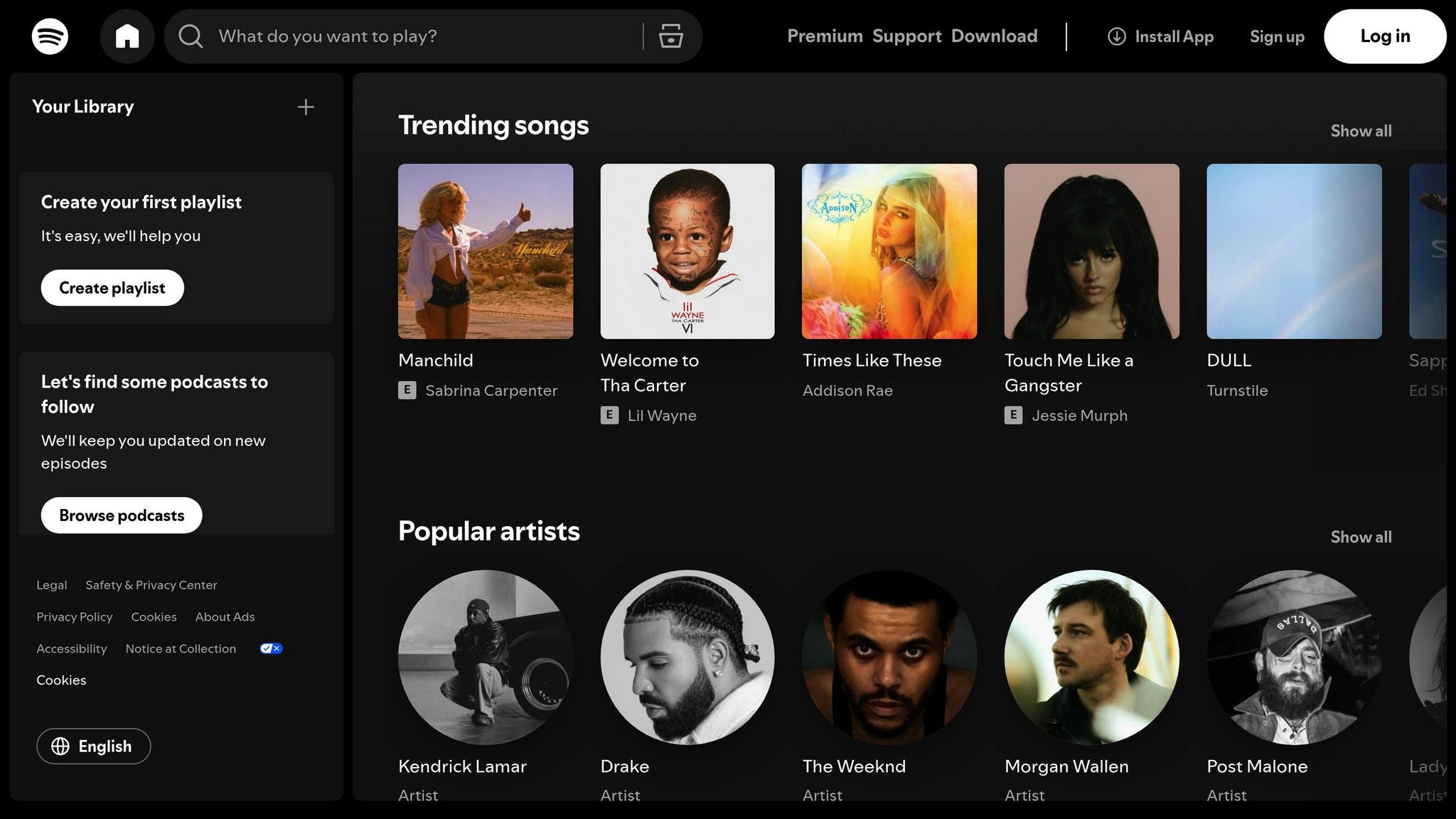
Spotify Wrapped is a standout among these content marketing examples, showcasing how user data can be turned into engaging, shareable personal stories. Each December, Spotify takes millions of listening habits and transforms them into vibrant narratives that users love to share across social media.
Turning Data Into Personal Identity
What makes Spotify Wrapped so impactful is the way it reimagines listening stats as part of a user’s personal identity. Instead of just displaying cold, hard numbers, Wrapped turns them into meaningful insights. Your top artist becomes “your soundtrack”, your most-played song is framed as “your anthem”, and those quirky genre combinations? They’re celebrated as part of your “musical identity” [57]. This approach works because people enjoy discovering more about themselves. Wrapped feels like a personality quiz, offering a fresh perspective on who you are and fostering a sense of connection and belonging [61]. By personalizing the data, Spotify not only strengthens user identity but also sparks immense social interaction.
Content Marketing Examples that Have Massive Social Media Impact
The social buzz Wrapped generates is nothing short of incredible. In 2022, over 156 million users engaged with Wrapped, and in 2021, nearly 60 million Wrapped stories and graphics were shared across social platforms [57]. The campaign even drove a 461% spike in Spotify Wrapped-related tweets between 2020 and 2021 [57]. These shares serve as organic marketing, turning users into enthusiastic brand ambassadors. And the results are tangible – Spotify saw a 21% rise in mobile app downloads during the first week of December 2020, right after Wrapped launched that year [57].
Design for Maximum Shareability
Wrapped’s visuals are designed to shine on social media. The graphics are bold, colorful, and perfectly optimized for platforms like Instagram Stories [57]. Every detail feels celebratory and easy to engage with, from the playful animations to the integrated share buttons that make posting effortless [58]. This seamless sharing experience eliminates barriers, encouraging users to spread their Wrapped stories far and wide.
Creating Cultural Moments
Spotify Wrapped has grown into more than just a year-end feature – it’s become a cultural event. Each December, it creates a buzz that users don’t want to miss out on, fueling a sense of FOMO [57].
“We started to realize that this was an incredible way to get our passionate users to shout from the rooftops around the brand.” – Alex Bodman, Spotify’s vice president and global executive creative director [60].
The campaign’s influence even extends beyond Spotify. Other brands have adopted similar formats, and TikTok users have launched trends like “Dating Wrapped” inspired by the concept [57].
Emotional Connection Through Music
Music has a unique way of connecting to emotions, and Spotify Wrapped taps into that beautifully. Sharing Wrapped isn’t just about stats – it’s a way to express who you are and what you value [57].
“It becomes a way for us to share parts of ourselves (ie. our music choices, artists we like) that can reveal so much about who we are.” – Geetu Vanjani, Senior Counsellor at the Indigo Project [59].
By sharing Wrapped, users turn Spotify into more than just a music app – it becomes a badge of identity and taste [57]. Comparing stats with friends adds a layer of fun competition, further deepening their bond with the platform [63].
Global Reach and Engagement
Wrapped’s appeal knows no boundaries. Analysis of 2.2 million social conversations revealed that the campaign resonated in over 50 countries, spanning more than 20 languages, and engaged users from five generations [62]. This blend of global reach and personal relevance showcases just how powerful data-driven storytelling can be. Spotify Wrapped proves that when done right, content marketing can connect with people on both an individual and universal level.
12. LinkedIn B2B Institute – Research Infographics
The LinkedIn B2B Institute excels at transforming complex marketing research into visually engaging infographics that connect with B2B marketers. By presenting data in a clear and impactful way, they showcase how data-driven content can establish authority and foster engagement.
Turning Research Into Visual Impact
Instead of burying valuable insights in lengthy reports, the LinkedIn B2B Institute distills its cutting-edge research into concise, visually appealing infographics. This approach resonates with B2B decision-makers, 73% of whom believe an organization’s thought leadership is a more reliable way to evaluate its expertise compared to traditional marketing materials like product brochures [64]. Marketing professionals, such as Jennifer Shaw-Sweet, often reference these visuals in LinkedIn Pulse posts to discuss topics like Memory Mix Modeling. By prioritizing visual storytelling over dense text, the Institute creates a more engaging way to share its findings.
The Design That Drives Attention
What sets LinkedIn’s infographics apart is their clean, professional design. They use ample whitespace to emphasize key points, while charts, graphs, and icons are paired with a consistent color palette for clarity and visual appeal. This thoughtful design simplifies complex data without losing its depth, making it easier for audiences to understand and engage with the content.
Earning Trust Through Expertise
These infographics do more than share data – they position LinkedIn as a trusted authority in B2B marketing. This trust directly contributes to business success, as LinkedIn generates 80% of B2B leads from social media and achieves conversion rates three times higher than other platforms [65].
“High-quality thought leadership is the closest thing to a secret weapon as exists in B2B marketing today.”
- Tequia Burt, Editor in Chief @ LinkedIn [64]
The Institute uses its research to spark meaningful conversations within the marketing community. By challenging conventional ideas and presenting bold perspectives, their infographics encourage discussion and sharing among industry professionals.
Infographics Built for Sharing
LinkedIn’s infographics are designed not only to inform but also to inspire action and conversation. Each one delivers actionable insights while reinforcing LinkedIn’s expertise. Their shareable nature ensures these visuals travel across professional networks, sparking discussions and extending their reach organically. This combination of trust, design, and shareability makes them powerful marketing tools.
13. BuzzFeed Quizzes – Interactive Shareable Content
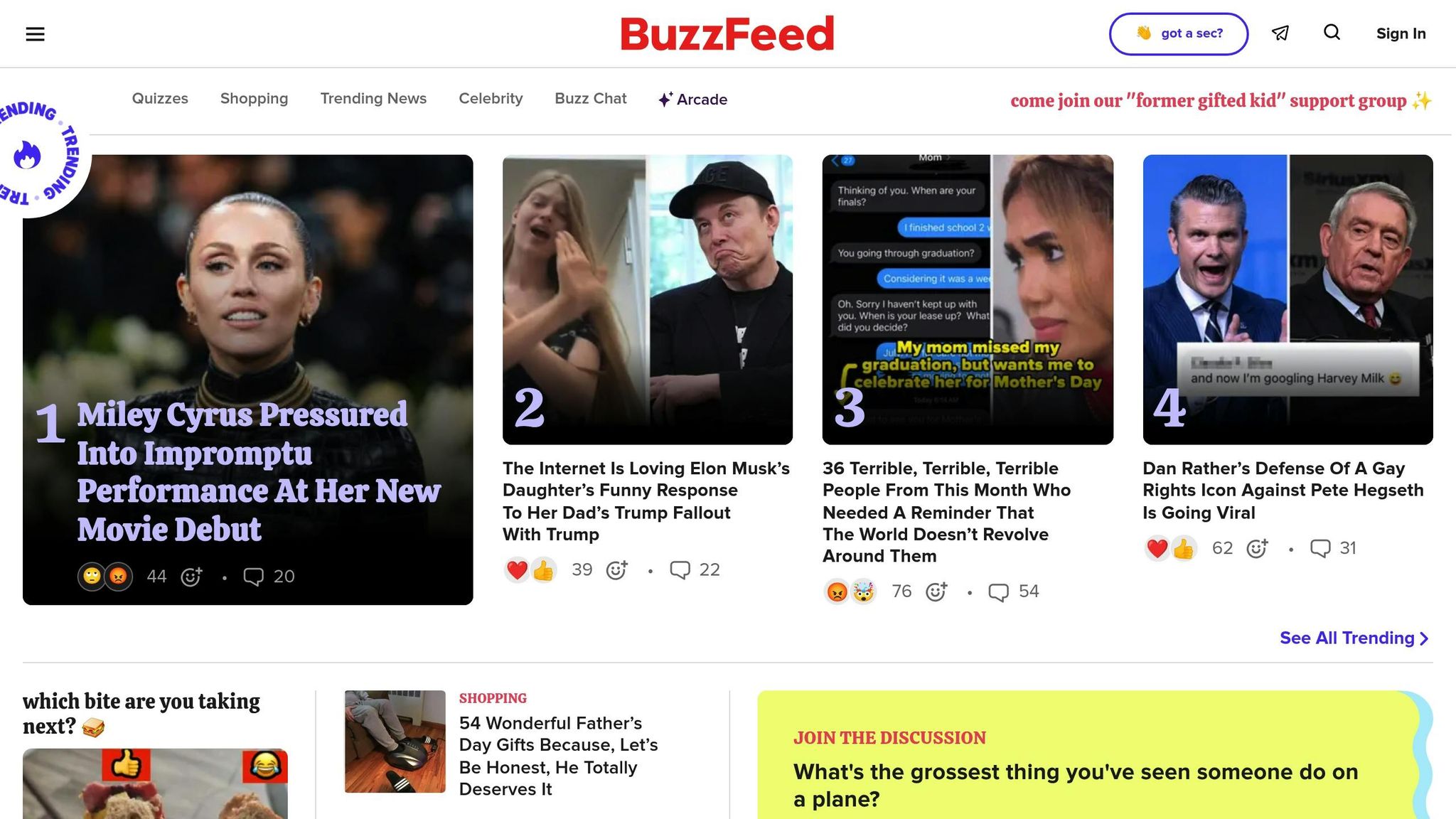
BuzzFeed’s quizzes have mastered the art of turning casual readers into active participants, creating a ripple effect of engagement across social media. Here’s a closer look at what makes this content format so impactful.
The Psychology Behind Quiz Success
BuzzFeed quizzes tap into something we all love: discovering more about ourselves. They transform a simple activity into a fun, game-like experience where participants feel rewarded with insights about their personality, preferences, or identity. By using titles that include “you”, the quizzes feel personal and inviting.
An impressive 96% of users complete these quizzes [66][67], which speaks volumes about their magnetic appeal.
How They Go Viral
The magic of BuzzFeed’s quizzes lies in their built-in shareability. Results are crafted to encourage users to post them on social media, sparking curiosity and engagement among their friends. This creates a viral loop where each share leads to more users discovering and taking the quiz.
On average, BuzzFeed quizzes generate 51,968 Facebook shares, significantly outpacing the 15,527-share average for top articles [66]. Some quizzes, like “Can we guess your real age?”, have been taken 5.9 million times, while others have racked up over 22 million views and 2.9 million shares [66][67].
A Winning Content Strategy
BuzzFeed’s secret sauce is focusing on universally relatable topics like personality traits, pop culture, and lifestyle choices. Instead of pushing direct brand messages, they prioritize entertainment and engagement. With over 650 million users and 9 billion monthly views [66], their strategy is amplified on a massive scale.
Takeaways for Marketers
Marketers can learn a lot from BuzzFeed’s approach. By shifting the spotlight from their brand to their audience, they create content that entertains, engages, and adds value.
“Quizzes currently offer some of the best return on investment that you can hope for in Internet marketing.” – Steve Olenski, Contributor to Forbes [66]
Interactive content like quizzes delivers 52.6% more engagement than static formats [68], making it a powerful tool for brands. When done well, quizzes not only grab attention – they spark conversations that keep your brand in the spotlight long after the first click.
14. Loom Video Library – Product Demo Videos
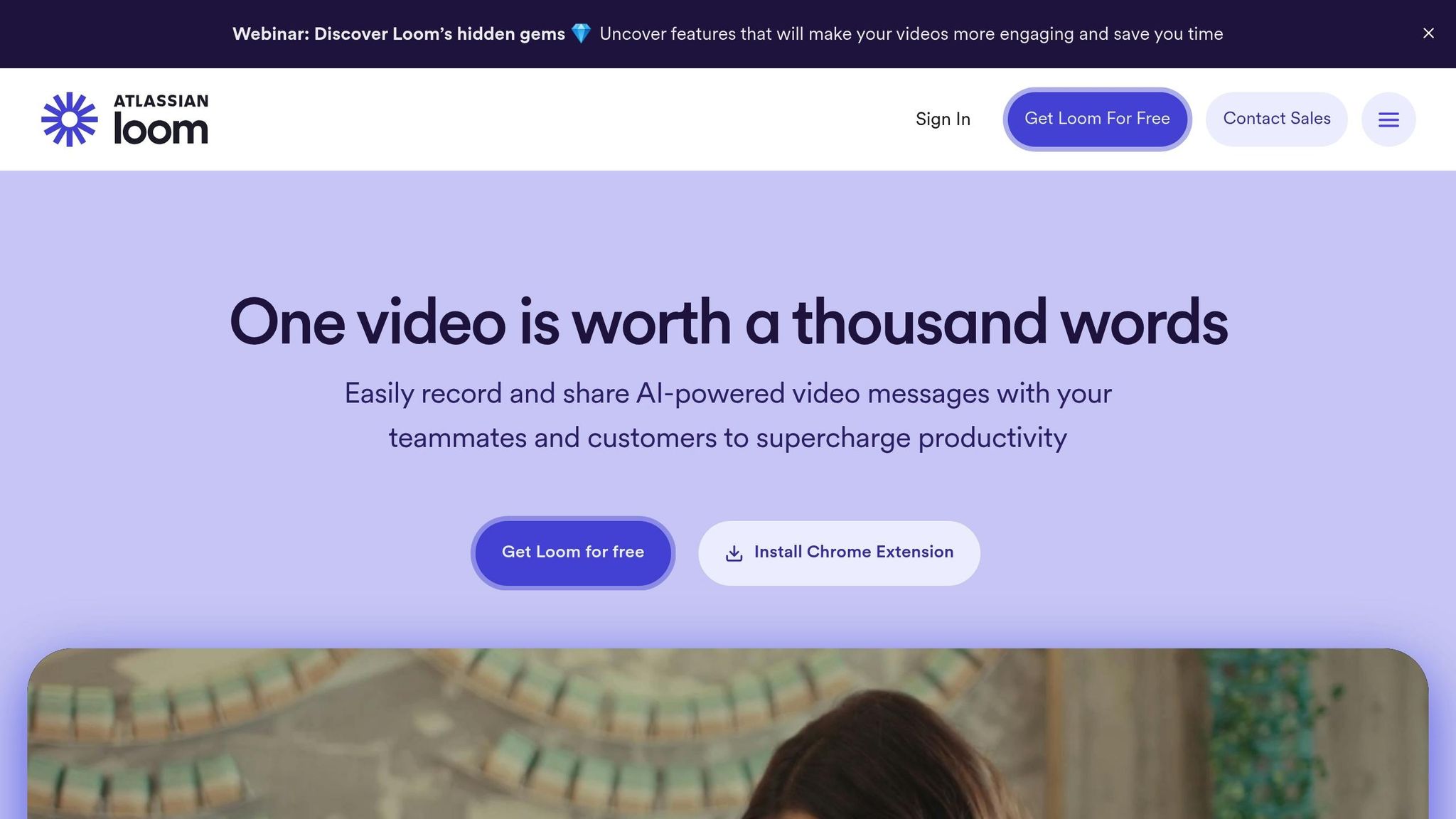
Loom’s video demos highlight the power of creating content that feels personal and approachable. Instead of relying on overly polished corporate-style videos, Loom has built its strategy around authentic, conversational demonstrations. These demos not only explain their product but also establish trust and drive conversions.
The Human Face Behind the Screen
Loom’s standout feature is its unique blend of screen recording paired with webcam footage. That small face bubble in the corner? It does wonders for building trust. Seeing an actual person explain features creates a connection that a faceless voiceover simply can’t replicate.
“Loom, with the little face bubble in the corner, is so powerful. It works so much better than traditional formats, where an audio track runs over animation or a slideshow. Having a real face in the corner adds personality and brings the storytelling to life.” – Chris Radtke, Sr Director of Content Marketing, Braze [74]
This approach taps into how we naturally communicate. Research shows that only 7% of communication comes from words, while 93% is conveyed through voice, tone, and body language [70]. By showing their faces, Loom’s presenters make full use of these non-verbal cues to strengthen their message.
Real Leaders, Real Results
Loom takes things a step further by demonstrating how their own team uses the product daily. For example, CEO Joe Thomas and Account Executive Charles Dennis create layered demos that showcase actual workflows and highlight the product’s benefits. This approach turns cold outreach into warm, engaging connections [72].
It’s no surprise this strategy resonates. Video is the preferred learning format for 83% of people, and Loom’s personal touch makes even the most complex features easy to understand [73].
The Personalization Advantage
Loom doesn’t stop at standard demos. They’ve mastered personalized video outreach, which has been shown to convert 37% better and achieve 4.5 times higher click-through rates. Brands like Intercom and Braze have seen measurable success with this strategy [75][76].
For example:
- Intercom used Loom’s personalized video approach to boost cold email response rates by 19%, generating $120,000 in revenue [76].
- Braze leveraged Loom to improve keyword indexing and saw an 18% increase in organic traffic within weeks [76].
This kind of tailored content doesn’t just grab attention – it delivers results.
Making Complex Simple
By combining visual demonstrations with a human touch, Loom simplifies even the most intricate features. This matters because 95% of purchasing decisions happen subconsciously, and video communicates information far more effectively than text [70].
Metalab’s product design team is a great example. They used Loom to reduce meetings and boost design productivity by 20% [73]. Instead of lengthy email chains or endless meetings, Loom videos allowed them to share design decisions and feedback quickly and clearly.
“Loom allows me to connect more personally with people without having to do 75 different one-on-one calls, which is just impossible at scale.” – Katie Burke, Chief People Officer, HubSpot [74]
The Trust Factor in Action
Loom’s strategy revolves around showcasing real people solving real problems. This approach works: 94% of customers say product videos increase trust during the sales process [71].
Chris Radtke from Braze summed it up perfectly when he said Loom gave them an affordable way to create personalized content without relying on expensive production teams [69]. It’s proof that authenticity can beat perfection in B2B marketing.
The takeaway? Your audience wants to see the faces behind your brand. By blending expertise with a personal touch, Loom has created content that not only educates but also builds lasting relationships – fueling business growth along the way.
15. Zendesk Customer Stories – Short Case Studies
Zendesk turns customer feedback into engaging, conversion-driven content. Instead of sticking to traditional, dry case studies, they craft dynamic video stories that combine real-world challenges with measurable business outcomes. This approach shows how Zendesk transforms customer experiences into tangible results.
The Problem-Solution Formula That Delivers
Each Zendesk customer story follows a straightforward structure: challenge, solution, and outcome. Take their PURE Insurance case study, for example. Rather than diving into product features, the story starts with a relatable problem – PURE needed to streamline their ticket escalation process.
“Zendesk helps reduce friction in our ticket escalation process by empowering teams to collaborate and share information smoothly, which creates a better experience for agents, brokers, and customers.” – Howard Muhlstein, Vice President of Infrastructure Services, PURE Insurance [77]
This quote illustrates how Zendesk goes beyond selling software. It’s about improving workflows, empowering teams, and creating better experiences for everyone involved.
Emotional Connections That Resonate
Zendesk’s customer stories tap into real emotions, showcasing frustrations with inefficiencies and the relief that comes with effective solutions. These narratives strike a chord with business leaders who value relatable, human experiences.
“We’re all customers, and we’ve all had good and bad customer experiences. And so we like to tap into those stories to make it personal.” – Ethan Kanat, Senior Creative Principal at Zendesk [78]
This emotional appeal works. Research reveals that 72% of customers say positive reviews and testimonials influence their trust in a company [80].
Data That Speaks Volumes
Zendesk backs its storytelling with hard numbers. For instance, in their Lush case study, Zendesk’s solutions led to a 369% ROI, a 17% boost in service agent productivity, a 30% increase in manager productivity, and annual savings of over £350,000 ($434,000) [79].
These figures give decision-makers clear, quantifiable reasons to consider Zendesk as a valuable partner.
Tailored Stories for Maximum Relevance
Zendesk enhances the impact of its testimonials by making them easy to explore. Their customer stories page allows visitors to filter by industry, use case, or location [80]. This targeted approach helps potential customers find stories that align with their specific challenges, making it easier to see how Zendesk could work for them.
Wavy: Feedback as a Game-Changer
One standout example is Wavy, where Zendesk helped transform their customer experience by prioritizing feedback.
“Customer feedback is now at the heart of our Customer Experience strategy at Wavy, and thanks to Zendesk, we have been able to better respond to it, develop it, and enhance it.” – Romain Rodriguez, Head of Customer Support at Wavy [81]
This highlights Zendesk’s role in driving not just operational improvements but also broader business evolution.
Why This Strategy Works
By prioritizing customer needs over product features, Zendesk builds trust and drives conversions. In fact, three out of four customers are willing to spend more with businesses that deliver excellent customer experiences [77]. This approach underscores Zendesk’s ability to connect emotionally, deliver measurable results, and inspire confidence – all while strengthening their brand.
For marketers, the lesson is clear: craft customer testimonials that tell complete, relatable stories. Focus on real emotions, specific outcomes, and meaningful business value. When done well, these stories can become some of the most effective tools for building trust and driving conversions.
Content Marketing Examples Comparison Table
Different types of content play a crucial role in creating strategies that engage audiences at every stage of their journey. Each format brings its own strengths, from building trust to sparking meaningful interactions.
In fact, a well-planned mix of content types doesn’t just outperform single-format strategies – it can generate three times more leads per dollar while reducing costs by 62% [2]. The table below highlights how each content format contributes to a well-rounded content marketing strategy.
| Content Type | Primary Purpose | Key Benefits | Best Example | Conversion Impact |
|---|---|---|---|---|
| Educational Blog Content | Inform and establish authority | SEO boosts, long-term value, builds credibility | HubSpot’s how-to guides | B2B companies that blog see 67% more leads than those that don’t [84] |
| Social Media Content | Engage and build community | Real-time interactions, viral potential, brand personality | Duolingo’s TikTok content | Social videos generate 1,200% more shares than text or images [83] |
| Data-Driven Content | Build credibility through insights | Positions brand as an authority, shareable, industry relevance | Spotify Wrapped | 90% of B2B buyers research 2-7 websites before making a purchase [2] |
| Interactive Content | Create personalized experiences | Higher engagement, lead qualification, memorable interactions | BuzzFeed quizzes | Interactive content creates tailored experiences that increase engagement [85] |
| Video Content | Demonstrate and connect emotionally | Emotional storytelling, product demos, trust building | Loom’s product demonstrations | 93% of consumers say videos help them make buying decisions [84] |
| Customer Stories | Prove value through social proof | Builds trust, optimizes conversions, relatable | Zendesk’s case studies | 72% of customers say positive testimonials influence their trust [80] |
Blog content is a powerhouse for building long-term relationships and improving search engine visibility. Brands like HubSpot and Canva use educational posts to guide readers toward their products while offering genuine value. This works because audiences are more influenced by consistent, high-quality content than by any other tactic [1].
Social media content thrives on its immediacy and ability to show personality. Companies like Duolingo and Ryanair excel by tapping into platform-specific trends and timely moments. The short-lived nature of social posts encourages experimentation and fosters emotional connections with audiences.
Data-driven content elevates brands as thought leaders. Spotify’s Wrapped campaign is a prime example – it transforms user data into highly shareable stories, combining personal relevance with viral appeal. This aligns with findings that 86% of B2B marketers consider brand awareness the top benefit of content marketing [84].
Interactive content grabs attention by actively involving the audience. BuzzFeed quizzes are a classic example, offering personalized results that users love to share. This type of content not only boosts engagement but also strengthens brand recognition.
Video content blends visuals with emotional storytelling, making it incredibly effective. Loom’s product demo videos illustrate how showcasing products in action builds trust and credibility. It’s no wonder that users spend 88% more time on websites featuring videos [82].
Customer stories provide the social proof that drives conversions. Zendesk’s case studies combine emotional narratives with measurable outcomes, making them relatable and persuasive. This approach works because 93% of marketers agree that user-generated content outperforms traditional branded content [86].
Conclusion
The most effective content marketing examples resonate with emotional, creative, or practical needs, rather than simply following trends. As Harvard Business School professor Gerald Zaltman points out, 95% of our buying decisions are made in the subconscious mind [90]. This insight explains why brands like Duolingo and Ryanair thrive – not because of flawless production, but through their ability to forge emotional connections.
The 15 examples we’ve explored highlight a key takeaway: genuine connections matter more than striving for perfection. For instance, when Loom shares straightforward product demos or Zendesk highlights real customer stories, they’re addressing real-world challenges. This approach is powerful, especially since 81% of consumers say trust is essential before they’ll make a purchase [88].
To succeed, focus on your brand’s personality, tone, and messaging [88]. Rick Holberg, GAVIN’s Vice President of Creative, offers a great perspective on this:
“Think of guidelines as guardrails, not roadblocks. They provide clarity but still leave space to play.” [88]
You’ve probably noticed that these content marketing examples start with a clear understanding of your brand’s values and mission [87]. Whether it’s HubSpot’s educational content or Morning Brew’s witty, data-driven approach, the formats you choose should reflect your brand’s essence. Interestingly, only 37% of marketers have a documented content strategy, even though consistency can boost revenue by 10% to 20% [87]. This gap presents a big opportunity for brands willing to take a more deliberate approach.
Define what sets your brand apart and adapt these examples to fit your unique voice and audience. Tools like A/B testing can help you refine your content and discover what resonates most [87]. And don’t forget: content marketing generates three times more leads than traditional outbound methods while costing 62% less [89]. These numbers highlight just how impactful a thoughtful content strategy can be.
FAQs
How can brands use humor in content marketing without losing their professional image?
Brands can effectively weave humor into their content marketing by making it relatable, genuine, and consistent with their brand identity. The key is to truly understand your audience – what tickles their funny bone and aligns with their values? Humor that feels natural and mirrors their experiences tends to leave a stronger impression.
Consider using lighthearted memes, witty language, or even sharing behind-the-scenes moments to add a human touch to your brand. Just make sure the humor enhances your message rather than overshadowing your professionalism. When done right, humor can create an emotional connection with your audience while keeping your brand credible.
What makes data-driven campaigns like Spotify Wrapped so engaging and widely shared?
Data-driven campaigns like Spotify Wrapped stand out because they masterfully blend personalization, eye-catching visuals, and emotional storytelling. By giving users a customized breakdown of their listening habits – like their top songs, favorite genres, or most-played artists – Spotify makes the experience feel personal and meaningful. The bold, shareable graphics make it effortless for users to post their results on social media, sparking conversations and comparisons with friends.
What makes these campaigns even more engaging is the element of surprise and delight. They reveal unexpected insights about users’ habits, turning raw data into stories that feel fresh and exciting. This approach not only highlights individuality but also creates a sense of connection and community, as people celebrate their unique tastes while discovering others with similar preferences.
How do interactive formats like quizzes boost user engagement compared to traditional content?
Interactive formats like quizzes are a great way to get users involved, transforming a passive browsing experience into an engaging activity. Unlike static content, quizzes draw people in by encouraging direct participation, making the interaction feel more meaningful and memorable. This kind of engagement often results in users sticking around longer and can even improve conversion rates.
Quizzes also offer important insights about your audience, allowing brands to refine their strategies and connect more effectively. By delivering a fun and tailored experience, interactive content grabs attention, inspires sharing, and helps build stronger brand loyalty and deeper engagement.







